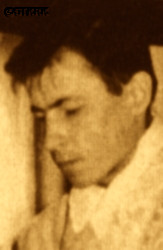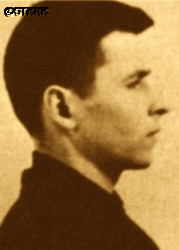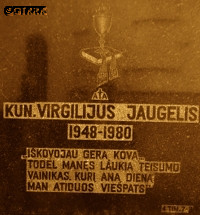Roman Catholic
St Sigismund parish
05-507 Słomczyn
85 Wiślana Str.
Konstancin deanery
Warsaw archdiocese, Poland
full list:
displayClick to display full list

searchClick to search full list by categories
wyświetlKliknij by wyświetlić pełną listę po polsku

szukajKliknij by przeszukać listę wg kategorii po polsku

Martyrology of the clergy — Poland
XX century (1914 – 1989)
personal data
religious status
Servant of God
surname
JAUGELIS
forename(s)
Wergiliusz
forename(s)
versions/aliases
Virgilijus
function
religious cleric
creed
Latin (Roman Catholic) Church RCmore on
en.wikipedia.org
[access: 2014.09.21]
congregation
Congregation of Marian Fathers of the Immaculate Conception of the Most Blessed Virgin Mary MICmore on
en.wikipedia.org
[access: 2013.05.19]
(i.e. Marians of the Immaculate Conception)
honorary titles
Cross of Vytis (Lithuania) — Officer’s 4th Classmore on
Cross of Vytis (Lithuania) – Officer’s 4th Class
(01.02.1999)
nationality
Lithuanian
date and place
of death
17.02.1980

Kaunastoday: Kaunas city dist., Kaunas Cou., Lithuania
more on
en.wikipedia.org
[access: 2022.06.29]
details of death
In 1960s–70s manual worker — driver — in Kaunas.
Participant of clandestine meetings of Lithuanian Catholics.
In c. 1971 during trial of Fr Joseph Zdebskis beaten up by the Communists for the first time.
Held in jail for 10 days.
In 1972 collected signatures under memorandum about Catholic Church status in Russian occupied Lithuania (17,000 signatures got collected).
Again held by Communists.
Threatened.
On 19.11.1973 Communist police searched his flat and confiscated a number of „Catholic Church in Lithuania Chronicle” clandestine magazines.
On 18.01.1974 again interrogated by Communist secret police.
Finally on 09.04.1974 arrested.
During trial in 12.1974 — could barely stand up from an illness contracted in prison — did not admit guilt.
Accused Russian occupying authorities of persecution of believers.
For possession of „illegal materials” and copier, editing and distribution of clandestine „Catholic Church in Lithuania Chronicle” sentenced to 2 years in prison.
Held in harsh Pravieniškės prison — former concentration camp Gulag — among hardened criminals.
Maltreated.
In 02.1975 cruelly beaten up.
Taken to hospital in Lukiškės prison in Vilnius.
There intestinal cancer diagnosed — as a result of beatings and lack of treatment.
In 05.1975 released and in 06.1975 undergone a surgery but never recovered.
In 12.1975 attempted to enter the trial of Sergiey Kovalyov, Russian dissident.
Arrested on spot and on 09.12.1975 sentenced to 15 days in jail.
During arrest beaten up again.
Signatory of many protests against Communists rule in Lithuania.
Perished in 1980 after many months in suffering bed without recovering.
cause of death
extermination
perpetrators
Russians
sites and events
Ribbentrop‐MolotovClick to display the description, Pius XI's encyclicalsClick to display the description
date and place
of birth
09.09.1948

Kaunastoday: Kaunas city dist., Kaunas Cou., Lithuania
more on
en.wikipedia.org
[access: 2022.06.29]
parents
JAUGELIS Vincent
🞲 ?, ? — 🕆 ?, ?

Monica
🞲 ?, ? — 🕆 ?, ?
presbyter (holy orders)
ordination
1978

positions held
1978 – 1980
priest — Kybartaitoday: Kybartai eld., Vilkaviškis dist., Marijampolė Cou., Lithuania
more on
pl.wikipedia.org
[access: 2022.12.04] ⋄ Eucharistic Saviour RC parish ⋄ Vilkaviškistoday: Vilkaviškis urban eld., Vilkaviškis dist., Marijampolė Cou., Lithuania
more on
en.wikipedia.org
[access: 2020.11.13] RC deanery
1978
accession — Marians of the Immaculate Conception MIC
1975 – 1978
employee — Kybartaitoday: Kybartai eld., Vilkaviškis dist., Marijampolė Cou., Lithuania
more on
pl.wikipedia.org
[access: 2022.12.04] ⋄ Eucharistic Saviour RC parish ⋄ Vilkaviškistoday: Vilkaviškis urban eld., Vilkaviškis dist., Marijampolė Cou., Lithuania
more on
en.wikipedia.org
[access: 2020.11.13] RC deanery — sacristan
1972 – 1978
student — Kaunastoday: Kaunas city dist., Kaunas Cou., Lithuania
more on
en.wikipedia.org
[access: 2022.06.29] ⋄ philosophy and theology, Theological Seminary (clandestine) — with a break for two years in a Commie–Nazi prison, 1974‐1976
others related
in death
LAURINAVIČIUSClick to display biography Bronislav, MAŽEIKAClick to display biography Leo, ZDEBSKISClick to display biography Joseph
sites and events
descriptions
Ribbentrop‐Molotov: Genocidal Russian‐German alliance pact between Russian leader Joseph Stalin and German leader Adolf Hitler signed on 23.08.1939 in Moscow by respective foreign ministers, Mr. Vyacheslav Molotov for Russia and Joachim von Ribbentrop for Germany. The pact sanctioned and was the direct cause of joint Russian and German invasion of Poland and the outbreak of the World War II in 09.1939. In a political sense, the pact was an attempt to restore the status quo ante before 1914, with one exception, namely the „commercial” exchange of the so‐called „Kingdom of Poland”, which in 1914 was part of the Russian Empire, fore Eastern Galicia (today's western Ukraine), in 1914 belonging to the Austro‐Hungarian Empire. Galicia, including Lviv, was to be taken over by the Russians, the „Kingdom of Poland” — under the name of the General Governorate — Germany. The resultant „war was one of the greatest calamities and dramas of humanity in history, for two atheistic and anti‐Christian ideologies — national and international socialism — rejected God and His fifth Decalogue commandment: Thou shall not kill!” (Abp Stanislav Gądecki, 01.09.2019). The decisions taken — backed up by the betrayal of the formal allies of Poland, France and Germany, which on 12.09.1939, at a joint conference in Abbeville, decided not to provide aid to attacked Poland and not to take military action against Germany (a clear breach of treaty obligations with Poland) — were on 28.09.1939 slightly altered and made more precise when a treaty on „German‐Russian boundaries and friendship” was agreed by the same murderous signatories. One of its findings was establishment of spheres of influence in Central and Eastern Europe and in consequence IV partition of Poland. In one of its secret annexes agreed, that: „the Signatories will not tolerate on its respective territories any Polish propaganda that affects the territory of the other Side. On their respective territories they will suppress all such propaganda and inform each other of the measures taken to accomplish it”. The agreements resulted in a series of meeting between two genocidal organization representing both sides — German Gestapo and Russian NKVD when coordination of efforts to exterminate Polish intelligentsia and Polish leading classes (in Germany called «Intelligenzaktion», in Russia took the form of Katyń massacres) where discussed. Resulted in deaths of hundreds of thousands of Polish intelligentsia, including thousands of priests presented here, and tens of millions of ordinary people,. The results of this Russian‐German pact lasted till 1989 and are still in evidence even today. (more on: en.wikipedia.orgClick to attempt to display webpage
[access: 2015.09.30])
Pius XI's encyclicals: Facing the creation of two totalitarian systems in Europe, which seemed to compete with each other, though there were more similarities than contradictions between them, Pope Pius XI issued in 03.1937 (within 5 days) two encyclicals. In the „Mit brennender Sorge” (Eng. „With Burning Concern”) published on 14.03.1938, condemned the national socialism prevailing in Germany. The Pope wrote: „Whoever, following the old Germanic‐pre‐Christian beliefs, puts various impersonal fate in the place of a personal God, denies the wisdom of God and Providence […], whoever exalts earthly values: race or nation, or state, or state system, representatives of state power or other fundamental values of human society, […] and makes them the highest standard of all values, including religious ones, and idolizes them, this one […] is far from true faith in God and from a worldview corresponding to such faith”. On 19.03.1937, published „Divini Redemptoris” (Eng. „Divine Redeemer”), in which criticized Russian communism, dialectical materialism and the class struggle theory. The Pope wrote: „Communism deprives man of freedom, and therefore the spiritual basis of all life norms. It deprives the human person of all his dignity and any moral support with which he could resist the onslaught of blind passions […] This is the new gospel that Bolshevik and godless communism preaches as a message of salvation and redemption of humanity”… Pius XI demanded that the established human law be subjected to the natural law of God , recommended the implementation of the ideal of a Christian state and society, and called on Catholics to resist. Two years later, National Socialist Germany and Communist Russia came together and started World War II. (more on: www.vatican.vaClick to attempt to display webpage
[access: 2023.05.28], www.vatican.vaClick to attempt to display webpage
[access: 2023.05.28])
sources
personal:
newsaints.faithweb.comClick to attempt to display webpage
[access: 2021.12.19], angelorum.ltClick to attempt to display webpage
[access: 2018.09.02], lt.wikipedia.orgClick to attempt to display webpage
[access: 2018.09.02]
original images:
www.lkbkronika.ltClick to attempt to display webpage
[access: 2018.09.02], www.lkbkronika.ltClick to attempt to display webpage
[access: 2018.09.02], angelorum.ltClick to attempt to display webpage
[access: 2018.09.02], genocid.ltClick to attempt to display webpage
[access: 2021.12.19], www.lkbkronika.ltClick to attempt to display webpage
[access: 2018.09.02], lkbkronika.ltClick to attempt to display webpage
[access: 2018.09.02], www.lkbkronika.lkbkronika.ltClick to attempt to display webpage
[access: 2018.09.02], angelorum.ltClick to attempt to display webpage
[access: 2018.09.02]
LETTER to CUSTODIAN/ADMINISTRATOR
If you have an Email client on your communicator/computer — such as Mozilla Thunderbird, Windows Mail or Microsoft Outlook, described at WikipediaPatrz:
en.wikipedia.org, among others — try the link below, please:
LETTER to CUSTODIAN/ADMINISTRATORClick and try to call your own Email client
If however you do not run such a client or the above link is not active please send an email to the Custodian/Administrator using your account — in your customary email/correspondence engine — at the following address:

giving the following as the subject:
MARTYROLOGY: JAUGELIS
To return to the biography press below:
 Click to return to biography
Click to return to biography















